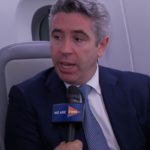Alan Peaford talks to Andrew O’Connor from SITA on how the company is using everything from kiosks to biometrics to improve passenger safety
Economic recovery after the COVID-19 pandemic will rely on passengers getting up in the air again.
But two things are needed for this to happen at every touchpoint through the boarding process – from airport, to airline and through to border control. The first is passenger confidence and the second is making better use of technology to enhance safety.
Hands-free is key
FINN spoke to Andrew O’Connor, Vice President, Air Travel Solutions at SITA about how technology can be used to get people travelling again. One of the first aspects which will change is improving hygiene by using hands-free technologies and devices or processes which can be completed using customer’s own mobiles.
“One of the really big areas we’ve been working on for a few years, but which we see a lot of kind of accelerated interest in is in the area of biometrics. The idea that you can enrol your face as you meet the first touch point in the airport, and then use your face to move through the rest of the airport.”
“So, for example, you might look into the camera at a self service kiosk, and then use your face to go through the automatic self service gate going from land side to airport, land side to air side in the airport, and then also to actually open up the self service gate boarding the aircraft. So that kind of leveraging of stuff that’s already been done, we see that there’s a big extra interest in that.”
Systems modified for masks
O’Connor added that the system would be able to be modified to read faces through masks, which are now compulsory at many airports. He added that greater collaboration would be needed between governments and airlines to enable a joined up approach to new technology processes around the use of face biometrics, linking face biometrics to the biometric in people’s passports.
Ensuring passengers are well enough to travel will become equally as important as security clearance and using hands-free systems to ensure the public have confidence in air travel. O’Connor explains: “The idea that people, the governments may be more interested in passengers having a way to report their health status, indeed leading towards that kind of health passport type idea that you are starting to see different people talking about, we see that big trend, as well as those things within the airport side.”
“For example, again, it’s an area where we have a number of technologies which are used to plan where flights are located in the airport. And when travel starts up again, we can see that airports want to keep flights separated as much as possible. While the volumes are small, to make sure that things like flights don’t take place at adjacent gates if they don’t have to, in their space.”
Rolled forward investment will help economies recovery
Travel bans, border closures and restrictions put in place around halting the spread of COVID-19 have led to a freefall in both demand and revenues. With alterations now needed to systems and processes within airports and aircraft, the question is, who will pay?
O’Connor said the solution lay in “leveraging what’s already out there.” He explained: “The fact that there are very large infrastructure platforms that many, many airports, which can be configured in a way that allows travel to be turned on again in the right way, like this low touch stuff and biometrics which is already out there.”
“I think it’s not so much about large investments. It’s about rolling out stuff which builds on a foundation that’s already been invested in more rapidly. So it’s not really about big expenditure for airports or airlines at all. It’s about leveraging what’s really out there, and about seeing some of the more innovative stuff coming around faster.”
“Governments are very keen to do things which enable travel to switch on again. And as things open up again, we’re standing by, we’re already talking to many, many countries, about how to switch on the new rules that allow people to start flowing into the country again. So we don’t see so much of a cost issue at all with government. We think governments are willing to spend what they need to to switch their economies on again.”

